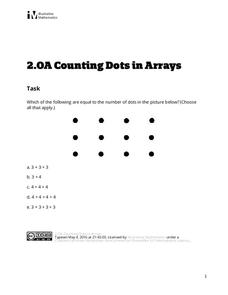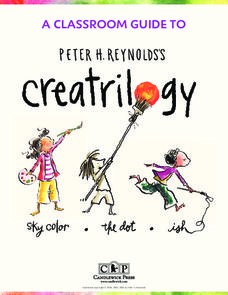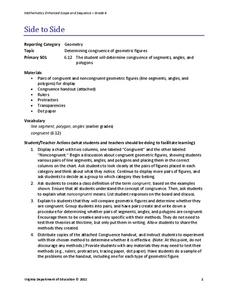Curated OER
Australian Aboriginal Art and Storytelling
Young explorers investigate Australian Aboriginal culture by listening to traditional Dreamtime stories and examining dot paintings created by Aboriginal artists. In addition, they locate the country on maps, discuss the geography of...
Illustrative Mathematics
Counting Dots in Arrays
Mathematical arrays can represent several different math skills, including counting groups, multiplication, and even area. In this specific task, learners are asked to identify the addition equations that are equal to a 3 x 4 array....
Teach Engineering
Quantum Dots and the Harkess Method
The Fantastic Voyage is becoming close to reality. The class reads an article on the use of nanotechnology in the medical field and participate in a discussion about what they read. The discussion method helps class members become more...
Candlewick Press
A Classroom Guide to Peter H. Reynolds's Creatrilogy
Help young readers find, identify, and use their voices with a set of empowering activities based on Peter H. Reynolds' trilogy of books. Sky Color, Ish, and The Dot focus on recognizing moods and treating each other...
Curated OER
Odd One Out
Which of these pictures doesn't belong? Based on the first picture in each row, learners circle the picture that doesn't rhyme with it. Then, they get printing practice with rhyming CVC words pie and cry by tracing an outline....
Willow Tree
Line Plots
You can't see patterns in a jumble of numbers ... so organize them! Learners take a set of data and use a line plot to organize the numbers. From the line plot, they find minimum, maximum, mean, and make other conclusions about the...
EngageNY
Using Sample Data to Compare the Means of Two or More Populations II
The 23rd segment in a series of 25 presents random samples from two populations to determine whether there is a difference. Groups determine whether they believe there is a difference between the two populations and later use an...
Teach Engineering
New Perspectives: Two-Axis Rotation
Two-axis rotations ... twice the fun as one-axis rotations! The last installment of a five-part module teaches scholars how to conduct two-axis rotations. They create isometric drawings before and after the rotations.
August House
A Tale of Two Frogs
Ribbit ribbit! Hop through a series of activities based on A Tale of Two Frogs. Kids read the Russian folktale and answer reading comprehension questions before working on phonics exercises, tracing dotting lines to make a path...
EngageNY
Two Graphing Stories
Can you graph your story? Keep your classes interested by challenging them to graph a scenario and interpret the meaning of an intersection. Be sure they paty attention to the detail of a graph, including intercepts, slope,...
Virginia Department of Education
Side to Side
Congruent figures: two figures that want to be just like each other. Individuals learn to distinguish between figures that are congruent and those that are not. Measuring the lengths of line segments and angles helps in this endeavor.
Curated OER
Size of Atoms - Trends
This compendious collection of slides leaves no questions when it comes to the concept of atomic size. Thorough and easy-to-read graphs, tables, and graphics explain atomic radii, the shielding effect, the octet rule, isoelectric...
Curated OER
2001 U.S. National Chemistry Olympiad National Exam Part II
Only eight problems are on this competitive national chemistry exam. It required the balancing of chemical equations, solving stoichiometry questions, and more. This is part two of three of the national exam. Also available is a...
Curated OER
2002 U.S. National Chemistry Olympiad National Exam - Part I
As to be expected from the American Chemical Society Olympiad Examinations Task Force, this 60-question test tops the charts in terms of excellence. It consists entirely of multiple choice questions designed to assess a year's worth of...
TLS Books
Dot-to-Dot Puppy
Connect the dots to complete a huge puppy! What preschooler or kindergartener wouldn't find such a task rewarding? The dots are numbered from 1 to 30, so this will definitely meed Common Core counting and cardinality standards for...
Curated OER
Coconut Tree Connect-the-Dots
In this connect-the-dots worksheet, students start at the number 1 and connect the dots up until the number 20 to complete the picture of the coconut tree.
Curated OER
Dot To Dot Seurat
Students discuss the art of Georges Seurat and examples of Pointillism and create original works of Pointillism using colored, sticker dots. This lesson is intended for use in the elementary Art classroom and includes a short vocabulary...
Curated OER
Connect the Dots
In this connect the dots worksheet, learners connect the dots to create a picture of a cliff over the sea. The numbers range from one to twenty-three.
Curated OER
Connect-the-Dots Activity
In this connect-the-dot activity, students start at the number 1 and connect the dots all the way up to the number 85 to reveal the picture on the page.
Curated OER
Using Tens Frames To Build Addition And Subtraction Facts To Ten
Students review the basic addition facts through ten. They use tens frames to show number patterns and number families. They also form subtraction facts to ten using dot patterns on a quinary frame. Given a number sentence they find...
Curated OER
Numbers Dot to Dot
In this numbers dot to dot worksheet, students draw lines from 1 to 44 to complete a picture. In this drawing worksheet, students create one picture.
Curated OER
Number Words - Zero to Ten
In this number words crossword puzzle learning exercise, students use the 10 sets of dots as clues for the number words needed to complete the word puzzle.
Curated OER
Matching Numbers With Counted Dots
In this matching numbers with their sums worksheet, students cut out number squares from one to thirty and squares with dots and match them on the two matching board jars. Students solve thirty problems.
Curated OER
Count the Dots on Each Die
Kindergarteners use the dice reproduced on this worksheet to demonstrate their understanding of concepts of addition and missing numbers. After counting the dots on each die, young mathematicians write the number below each picture. They...























